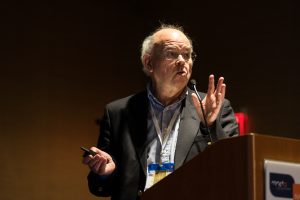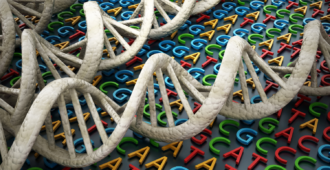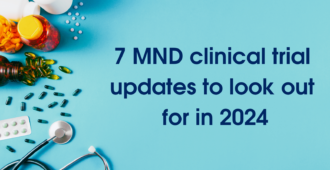Following on from our previous catch-up blog on clinical management talks presented at the Symposium, here is a continuation that looks at talks focusing on treatment therapies and causes of MND.
RNA Binding & Transport
RNA is the lesser-known ‘cousin’ of DNA – it contains copies of genetic instructions sent out from the nucleus – the ‘control hub’ of every cell. This RNA is carried out of the nucleus by lots of different proteins, including the RNA-binding proteins TDP-43 and FUS, which act as ‘couriers’ dropping off their RNA at the right part of the cell and then returning to the nucleus for the next package.
These binding proteins both play an important role in motor neurone health. In motor neurones affected by MND, the TDP-43 and FUS seem unable to make their way back to the nucleus so they form clumps in other parts of the neurone. How and why this happens is not really understood and several presentations on the first day of the Symposium provided insight into what might be going wrong. Dr Brian Dickie, Director of Research Development at the MND Association, summarises these presentations in his blog Libraries, Doormen and Harry Potter. You can also hear Brian talk about RNA proteins on the Symposium website.

Epidemiology is the branch of medicine that looks at the potential causes of MND by studying genetic, clinical and lifestyle information from groups of people affected by the disease. It then tries to identify associations between a range of environmental risks, such as exercise, diet and smoking, and aspects of MND such as age at onset, survival, and look for interactions between different risk factors. No one consistent environmental risk has yet been identified. It is thought that a pre-existing genetic flaw, combined with a number of environmental and lifestyle factors, eventually ‘tips the balance’ towards developing the disease. You can listen to Professor Ammar Al-Chalabi talk about the multi-step process of disease progression, with genetics and environment both playing a part (please note that the recording is from a different meeting).
Adriano Chio (C57) investigated the possibility of different genetic mutations shortening the multi-step process for MND. Dr Chio analysed data for the C9orf72, SOD1, TARDBP and FUS gene mutations. This identified a reduced number of steps in ALS patients, where these mutations were compared to those people without them. The results support the idea of MND being a multistep process. However, due to the small number of cases looked at, different mutations within each gene could not be investigated. Future work may include looking at where these steps take place in the cell and the body, and how genes are changed to cause the multistep process to shorten.
Henk-Jan Westeneng (C56) used a structured questionnaire to explore pre-symptomatic lifestyle factors of people with MND who carry a mutation in the C9orf72 gene, compared to non-carriers. The factors considered were leisure, occupation, alcohol, smoking, daily calorie intake and BMI. Statistical analysis showed that smoking and calorie intake were significantly higher, and alcohol intake was significantly lower in all people with MND compared to controls. The results showed that differences could be detected up to 50 years before first symptoms of weakness. As this is the first look at gene-environment interactions, more studies will need to be done to see if these findings can be replicated.
A study in the Netherlands, headed by Susan Peters (C59), explored the impact of smoking and found a clear increasing risk with the number of years smoked. A decreased risk was seen with each year after stopping. Although passive smoking wasn’t included in the study, it is recognised as an important area to look at in the future.
Certain types of food may be neuro-protective and helpful in relation to the development of MND. Elisabetta Pupillo (C58) considered whether foods that reduce free radicals, contain antioxidants, or have anti-inflammatory effects may help in the reduction of food contaminants. An example of risk reduction from increased intake involves tea and decaffeinated coffee. However, more data is required as the genetic makeup of individuals needs to be taken into consideration where increased risk has been found.
Biomarkers
Identifying a biomarker, a signature of biological change occurring in a disease, would greatly improve the speed and accuracy of diagnosing MND and tracking its progression. This would lead to earlier therapy interventions and tracing effectiveness of new treatments in clinical trials.
Mary-Louise Rogers (C45) presented findings on her study looking at a protein called p75, which is shed from injured nerve cells and traces of it can then be found in urine. Based on a small study they found that people with ALS had a significantly higher amount of p75 in urine than healthy participants, which was also lower than in pre-symptomatic patients. Further study will now investigate whether increased levels of p75 can be identified in people who haven’t yet developed the disease. This marker is starting to be incorporated into some clinical trials to measure effectiveness of the treatment.
A more widely-studied marker is the presence of neurofilaments in blood and CSF. Neurofilaments are ‘building blocks’ of motor neurones which, when motor neurones are diseased, collapse and leak out from the affected neurone. In his talk, Michael Benatar (C46) stressed the importance of catching ALS in the pre-symptomatic stages – that is, before any symptoms had occurred. Results from a clinical trial where he compared different groups of people based on their distance from disease onset and showed that people who were about one year from symptom onset had increased levels of neurofilaments. These were also increased in the first six months from symptom onset.

Clinical Trials & Treatments
Clinical trials play a vital role in the development of new treatments. They are difficult to design because of the varied range of presentations and progression seen in people with MND. Trials take many years and, in the end, the trial drug may never even be approved. For MND, the success rate in getting a drug from pre-clinical stages to approval has been frustratingly low, and so it is always great to hear about new developing treatments that may one day become available to treat MND.
You can read a detailed summary on each of the presented treatments (that is, masitinib, tirasemtiv, rasagiline, ibudilast, and edaravone) in one of our previous blogs.
You can also listen to a series of short videos about clinical trials and treatments on the Symposium website.
Therapeutic Strategies
The session started with a talk by Frank Bennett (C27) about antisense oligonucleotides. These are synthetic (‘man-made’) single-stranded strings of nucleic acids (the components of DNA and RNA) that bind to RNA that can alter how the RNA behaves. Antisense oligonucleotides can be delivered directly to the central nervous system (CNS) and have been shown to stay in the tissue for up to a year after dosing has occurred. Antisense oligonucleotides have been successfully used in spinal muscular atrophy (SMA), and this has led to the licensing of the first drug to be used as a treatment for SMA. Similar research is now looking at antisense oligonucleotides that will target the SOD1 gene in MND, with promising results seen in a SOD1 mouse model. Further tests will be carried out and will finish this time next year. Antisense oligonucleotides are also being developed for the C9orf72 form of MND and have shown some success in mice models. It is hoped that clinical trials will begin next year.
The blood-brain barrier (BBB) stops harmful compounds from entering the central nervous system (CNS) and causing damage. However, this also means that there are difficulties with useful drugs passing the BBB and some drugs are actively removed via proteins called glycoproteins. Steve Moore (standing in for Dr Walsh; C28) suggested that it may be possible to overcome this by using a ‘trojan horse’ approach – combining a drug with a molecule that the CNS accepts.
Ruben van Eijk (C30), talked about his paper that was recently published in the journal Neurology. This showed the importance of focusing on smaller subgroups when analysing the effectiveness of a drug, rather than concluding that it doesn’t work. The authors looked at trials of the drug lithium that were carried out several years ago, which showed that the drug was not beneficial in treating MND. Researchers then looked at whether lithium has an effect on certain subgroups of patients and found that people with the UNC13A gene showed an improvement in survival.
You can read more about Ruben’s work on our blog.
There is also a series of short videos in which professionals talk about clinical trials and treatments.
Pre-approval Access
This session considered how patients with life-threatening diseases can access treatments which are not yet licensed or approved by a regulator in the United States. When there is no comparable or alternative therapy to diagnose, monitor or treat a condition, Expanded Access Programmes enable patients to use an unapproved product outside a clinical trial. However, this still requires an approval from the Food and Drugs Agency (FDA). The ‘Right to Try’ pathway aims to remove the need for FDA involvement but may also remove patient protections. Alison Bateman-House (C31) recommended expanded access as opposed to right to try.
Jess Rabourn (C31A) looked again at expanded access to unapproved treatments and how meaningful data collection may be obtained from group access, and that this should be made easier to accomplish. Individual cases fighting for expanded access gain media attention but have no added value in terms of research. Group data can help work out better defined target groups for testing within approved clinical trials.
To conclude the sessions, using the analogy of the Salem Witch Trials, Rick Bedlack (C32) tried to debunk some of the myths around ‘Right to Try’. As some patients will self-experiment with off label therapies anyway, perhaps clinicians should reconsider some of the perceived risks? With existing expanded access, there is little evidence of professionals being sued or harm being done to research studies. Perhaps it is time to facilitate shared decision-making about pathways to unapproved treatment.
You can read more about unproven treatments in our information sheet and on our website.
What lessons have we learnt?
- Different genetic and lifestyle risk factors may contribute to ‘tipping the balance’ towards developing MND. Although there are many studies looking at this, further research is still required before any definite associations can be made.
- The p75 biomarker found in urine is now being incorporated into clinical trials to confirm that it can help track treatment effectiveness.
- Increased levels of neurofilaments in the blood and CSF can be observed from pre-symptomatic stages of the disease.
- Only a very few clinical trials for new treatments progress to the point where a drug is put forward for licensing approval – there is hope that mastinib, currently being considered by the EMA, may be successful.
- Drugs that have had success treating other rare neurodegenerative diseases are now being applied to mouse models of some genetic forms of MND, with clinical trials begining next year for C9orf72 and TDP-43 mutations.
- Delivering drugs to the CNS is problematic because of the brain’s built-in defence mechanism, the blood-brain barrier, which might be overcome by combining a drug with a molecule that can pass into the CNS.
- Drugs that have previously been dismissed as having no value in treating MND may, actually, be beneficial in some subgroups of patients –showing importance of looking at subgroups when assessing a drug’s effectiveness.
- Allowing patients to try drugs that have not been proved safe and effective through clinical trials may be exposing the patient to risk.
- The existing expanded access programme, whereby patients can try drugs that have not undergone clinical trials but have been approved by the FDA, has not led to harm or litigation.
We would like to thank the staff that kindly provided their session summaries to allow us to keep you informed via a number of blogs, some of which are still on their way. Many thanks to Rachel Boothman, Kaye Stevens, Kirsten Kelly, Brian Dickie, Sarah Thompson, Martina Slapkova, and Mandy Spencer for collating these into an article.





